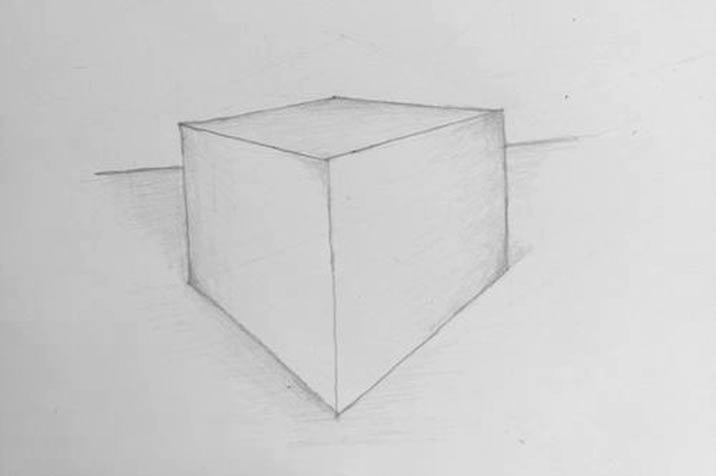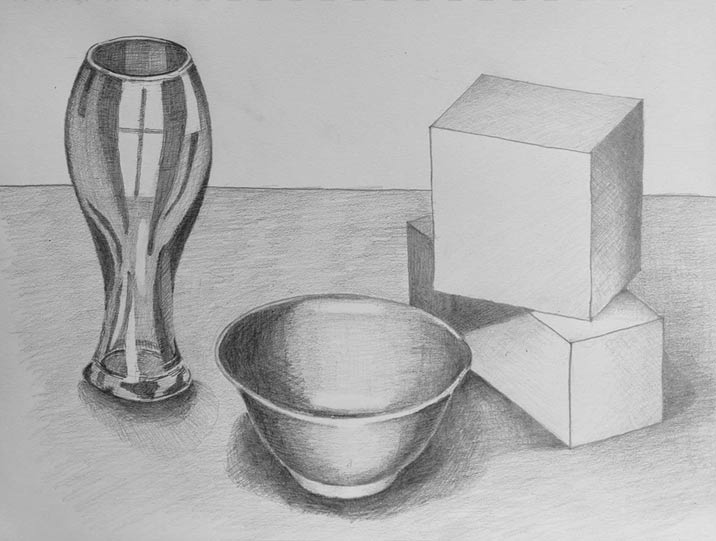
How to Improve Drawing Skills
We received a couple of drawings for critique from Igor, who is looking for the best way of improving his drawing skills. In this review, Vladimir London, a Life Drawing Academy tutor will assess Igor's level of skills and advise what gaps in drawing education Igor has and how to bridge those gaps the best way.
Dear Igor,
Thank you very much for your drawings. Looking at your artworks, I can say that you invested adequate efforts and time into making your drawings as best as you could. You have some knowledge of constructive drawing, attention to detail, and some skills of tonal rendering. This is great. Many self-taught artists would want to draw as good as you do.
If you need a very short summary of your drawing skills – you are just above the "complete beginner" level; on the scale from 0 to 10 it is about 0.5. Here's why.

Drawing of a cube
Although you were drawing a perfect model from life, the result doesn't look like a cube. You created an image of a severely distorted cuboid. If you want to check what is wrong, here's one good tip. Imagine that the bottom plane of this cube has a circle inscribed into it. This circle in perspective will appear as a perfect horizontal elliptical oval with its center in the middle of the cube's plane and the oval's outline will touch all four edges of that square in the middle of each side. In your drawing, it is not possible to inscribe such an oval, therefore this is not a cube.
I have to say that a proficient artist does not inscribe an oval every time one draws a cube. Correct perspective comes from what I call "sense of perspective". This is when an artist intuitively sees distortions and instantly understands what is right and what isn't in perspective drawing. Such a "sense" only comes with practice. When there is not enough practice, errors can be avoided by following certain perspective rules; this is what I call "drawing what you know". However, when the knowledge is missing, the only way to draw is from observation. Because people do not see what they don't know, this results in mistakes, which you illustrated so vividly.
Coming back to the cube drawing, out of 28 constructive drawing principles that are applicable to this artwork, you used only two. A level-one art student would know about those constructive drawing principles. Because you do not know what those principles are, this resulted in numerous mistakes. That is why I mentioned that your skills do not reach this level yet. For example, you completely ignored the aerial perspective. This type of perspective is not noticeable on such shallow object like a cube; nevertheless, a proficient artist has to use it to create an illusion of depth in drawing. This is another good example that skillful artists draw what they know, not what they see. A cube is the simplest three-dimensional object with well-defined height, width and depth. If you have challenges with the easiest task, there is no hope that more complicated objects would be any easier to draw. The list of what needs to be improved would be too long for this short critique. It begins with composition and scale, which is not sufficient for this paper size, and continues all the way to tonal rendering techniques and style, which I will explain on the example of your still-life drawing.

Still-life Drawing with tonal rendering
With constrictive drawing addressed above, let's talk about your tonal rendering skills. In short, one fundamental thing is missing – understanding that the purpose of tonal rendering is not to "decorate" objects with values, but to reveal their three-dimensional construction. If the purpose is misunderstood, then the techniques also would be erroneous. Although you tried to accurately repeat the chiaroscuro (light-and-dark) you see in life, this did not result in three-dimensional illusion. For example, the tonal aerial perspective of two boxes is reversed, so is perspective of the tabletop.
The direction of light is confusing. The casted shadow behind the bowl suggests that the light source is in front of this still-life, but the shadow in front of the glass tells the opposite.
When it comes to the rendering style, I can tell that your hand is not "setup". This means that there is no developed muscle memory, which would allow making beautiful pencil strokes on autopilot. Loops at the end of strokes show that you do not lift a pencil off the paper surface after each stroke, but glide it forth and back, which results in dull rendering. In some places, you use perpendicular cross-hatching that seldom looks good. There are many more things that should be improved, but I hope you already see the weak areas in your tonal rendering.
Many art college graduates have no better skills than you do; but this is not because your skills are perfect, but because constructive drawing and proper rules of tonal rendering are no longer taught at contemporary art colleges. There are only a few countries in the World left where art academies are following traditional classical art education. This video will tell you more about it:
https://lifedrawing.academy/life-drawing-academy-news/how-to-self-assess-your-drawing-skills
I understand that relocating for several years to learn strong drawing skills might not be an option for you. However, we can help, bringing this education into the comfort of your home. In the Life Drawing Academy Correspondence Course, you will get dedicated art tutors, who will walk you step-by-step, task by task, teaching all you need to know about all the needed topics, starting from very basic things like how to hold a pencil and make beautiful rendering marks, how to measure with a pencil and use constructive drawing principles including proportions, perspective, contours, how to draw whatever you see or imagine including man-made and organic objects, anatomy for artists, classical canons of human head and body proportions, how to draw portraits and figures, how to make beautiful compositions and so on. There will be 100 drawing tasks. Each task will be explained in depth and full critique provided on your artworks. Every next task will be given after you complete the previous one with quality required. This will ensure that you will reach the advanced level of drawing skills by the end of this course.
Should you decide to take our unlimited personal one-to-one tutoring, here's the link to enroll: https://lifedrawing.academy/correspondence-course
Kind regards,
Vladimir London
Art tutor
To learn good drawing techniques, enroll in the Life Drawing Academy course:
Online Course
A self-study, self-paced course for you to learn fundamental methods of classical drawing and improve life drawing skills by watching video lessons and doing assignments
- Unlimited access to 52 life drawing video lessons
- Lifetime membership without deadlines
- Unlimited support from the Academy tutors
- Constructive critique of your artworks
- Member access to the Academy's Art community
- Place in the Academy's Students Gallery
- Exclusive members-only newsletter and bonuses
- Life Drawing Academy Diploma of Excellence in your name
One-time payment - Lifetime membership
$297 USD
Personal Tutoring Online + Online Course
The ultimate choice if you who would like to receive personal, one-to-one tutoring from the Academy teachers, which is custom-tailored to your skills and needs
- Everything in Online Course, plus:
- Dedicated team of art tutors
- Assessment of your current level of drawing skills
- Personalized curriculum tailored to your skills and goals
- Up to 100 drawing tasks with by-task assessment
- Unlimited one-to-one personal coaching with detailed per-task instructions and feedback
- Artwork critiques and results-oriented guidance
One-time payment - Lifetime membership
$997 USD




